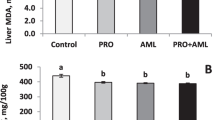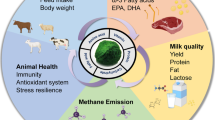Abstract
Feeding leguminous fodder that is high in protein can improve rumen fermentation parameters leading to increased digestibility and intake of low quality fibrous feeds, and hence improved animal production. The effect on dry matter (DM) degradation and rumen fermentation parameters of feeding urea or tree legume foliage (Erythrina poeppigiana or Gliricidia sepium), as protein supplements to a basal diet of Hyparrhenia rufa hay, rice bran and molasses, was studied with rumen fistulated steers (Zebu × Creole crossbreeds). In a second experiment, Jersey × Creole crossbreeds were used to determine the effect of the above three treatments on milk production. Both experiments were conducted at CATIE's experimental farm, Turrialba, Costa Rica (9°58′ N; 83°31′ W; 639 m above sea level; mean annual precipitation of 2600 mm; mean daily temperature 22 °C). The disappearance of hay DM in the rumen increased with time to 144 hours and potential degradation of hay DM was significantly higher (P < 0.05) for the legume diets compared to urea but there were no differences between legume species. Legume based rations resulted in total volatile fatty acid concentrations of rumen licor that were 15 to 24% higher than for urea based rations (P < 0.05). The concentration of rumen NH3-N was highest two hours after feeding and tended to decrease in time. The urea ration resulted in significantly higher NH3-N than the legume rations, reaching 45 mg/100 mL two hours after feeding. Milk yields did not differ (P > 0.05) when cows received either E. poeppigiana or G. sepium foliages as protein supplements (7.3 and 7.4 kg milk/cow/day, respectively) but they were superior (P < 0.05) to urea supplementation (6.7 kg milk/cow/day).
Similar content being viewed by others
References
Alagón GH (1990) Comparación del poró (Erythrina poeppigiana) con otras fuentes nitrogenadas de diferente potencial de escape a la fermentación ruminal como suplemento de vacas lecheras alimentadas con caña de azucar (Saccharum officinarum). MSc thesis, CATIE, Turrialba, Costa Rica
Baldwin RL and Koong LJ (1980) Mathematical modelling in analyses of ruminant digestive function: philosophy, methodology and application. In: Ruckebusch Y and Thivend P (eds) Digestive Physiology and Metabolism in Ruminants, pp 251–268. AVI, Westport, Connecticut
Butterworth MH (1967) The digestibility of tropical grasses. Nutrition Abstracts and Reviews 37: 349–368
Cotta MA and Hespell RB (1986) Protein and amino acid metabolism in ruminants. In: Milligan LP, Grovum WL and Dobson A (eds) Proceedings of the 6th International Symposium on Ruminant Physiology, pp 122–136. Prentice-Hall, Englewood Cliffs, NJ
Elliott R and Armstrong DG (1982) The effect of urea and urea plus sodium sulphate on microbial protein production in the rumens of sheep given diets high in alkali-treated barley straw. Journal of Agricultural Science 99: 51–60
Elliott R and McMeniman NP (1987) Supplementation of ruminant diets with forage. In: Hacker JB and Ternouth JH (eds) The Nutrition of Herbivores, pp 409–428. Academic Press, Sydney
Elliott R, McMeniman NP, Norton BW and Calderón Cortés FJ (1984) The food intake response of sheep fed five roughage sources supplemented with formaldehyde treated casein eight and without urea. Proceedings of the Australian Society of Animal Production 15: 337–340
Goodchild HK and McMeniman NP (1994) Intake and digestibility of low quality roughage's when supplemented with leguminous browse. Journal of Agricultural Science 122: 151–160
Hume ID (1970) Synthesis of microbial protein in the rumen. III. The effect of dietary protein. Australian Journal of Agricultural Research 21: 305–314
Ibrahim MA, Franco M, Pezo DA, Camero AR and Araya JL (2001) Promoting intake of Cratylia argentea as a dry season supplement for cattle grazing Hyparrhenia rufa in the subhumid tropics. Agroforestry Systems (this volume)
Kass M and Rodríguez G (1985) Evaluación nutricional de alimentos. CATIE, Turrialba, Costa Rica
Lucas HL (1957) Extra period Latin-square change-over designs. Journal of Dairy Science 40: 225–239
Minson DJ (1990) Forage in Ruminal Nutrition. Academic Press, San Diego, USA
Minson DJ and Milford R (1967) The voluntary intake of diets containing different proportions of legume and mature pangola grass (Digitaria decumbens). Australian Journal of Experimental Agriculture and Animal Husbandry 7: 546–551
National Research Council (NRC) (1989) Nutrient requirements of domestic animals; Nutrient requirements of dairy cattle. National Academy of Sciences, Washington, DC
Ndlovu LR and Buchanan-Smith JG (1987) The effect of supplementing corn cobs with lucerne hay, lucerne cell wall, a soybean protein isolate or higher fatty acids on intake, ruminal degradation and rate of passage in sheep. In: Rose M (ed) Herbivore Nutrition Research, pp 189–190. University of Queensland, Australia.
Nolan JV and Leng RA (1972) Dynamic aspects of ammonia and urea metabolism in sheep. British Journal of Nutrition 27: 177–194
Ørskov ER and McDonald I (1979) The estimation of protein degradability in the rumen from incubation measurements weighted according to rate of passage. Journal of Agricultural Science 92: 499–503
Pérez M, Harrison D and Elliott R (1981) Rumen fermentation and kinetics on diets of sugar cane juice and molasses. Tropical Animal Production 6: 359–363
Pezo D, Kass M, Benavides J, Romero F and Chaves C (1990) Potential of legume tree fodders as animal feed in Central America. In: Devendra C (ed) Shrubs and Tree Fodders for Farm Animals, pp 163–175. IDRC, Canada
SAS (1982) SAS User's Guide Basic. Statistical Analysis Systems Institute, Cary, North Carolina
Siebert BD and Hunter RA (1982) Supplementary feeding of grazing animals. In: Hacker JB (ed) Nutritional Limits to Animal Production from Pastures, pp 409–426. CAB International, Wallingford, UK
Silva AT and Ørskov ER (1985) Effect of unmolassed sugar beet pulp on the rate of straw degradation in the rumens of sheep given barley straw. Proceeding of the Nutrition Society 44: 50
Tilley J and Terry RA (1963) A two-stage technique for the in vitro digestion of forage crops. Journal of the British Grassland Society 18: 104–111
Tuen AA, Dahan MM, Young BA and Vijchulata P (1991) Intake and digestion of urea treatment, urea-supplement and untreated rice straw by goats. Animal Feed Science and Technology 32: 333–340
Van Soest PJ (1982) Nutritional Ecology of the Ruminant. O & B Books, Corvallis, OR, USA
Author information
Authors and Affiliations
Rights and permissions
About this article
Cite this article
Camero, A., Franco, M. Improving rumen fermentation and milk production with legume-tree fodder in the tropics. Agroforestry Systems 51, 157–166 (2001). https://doi.org/10.1023/A:1010607421562
Issue Date:
DOI: https://doi.org/10.1023/A:1010607421562




